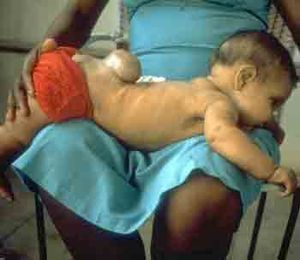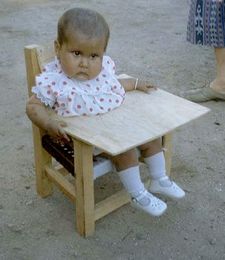Hesperian Health Guides
Prevention of Pressure Sores and Injuries
HealthWiki > Disabled Village Children > Chapter 22: Spina Bifida > Prevention of Pressure Sores and Injuries
As a child who has no feeling in parts of his body grows older and heavier, there is increasing danger that pressure sores (bed sores) will form over bony areas that support his weight (mostly his butt or his feet). To prevent this:
- Have the child sleep and sit on a mattress or cushion that is soft (such as foam rubber), and move or turn over often.
- Examine the child’s lower body daily for early signs of irritation or sores. Check especially the hips, knees, and feet.
- When he is a little older, the child can learn to check his own body each day for sores.
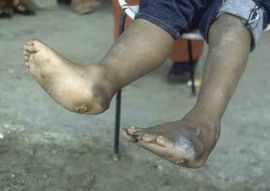 |
| This child with spina bifida cut her feet on broken glass. Because the cuts did not hurt, they were neglected and became severely infected. In time, the infection spread to the bones in both her feet and began to destroy them. As a result, her feet are very deformed and she may lose them completely. |

WARNING! Whether the cause is spina bifida or leprosy, children who walk but have no feeling in their feet run a high risk of cuts, burns, sores, and serious infections on their feet. Teach them to check their feet every day.
Also, be sure that sandals, shoes, and orthopedic braces fit well and do not cause blisters or irritation.
You will find other important information that relates to a child with spina bifida in other chapters of this book, especially:
Chapter 23, “Spinal Cord Injury”
Chapter 24, “Pressure Sores”
Chapter 25, “Urine and Bowel Management”
Also refer to the chapters on contractures, club feet, exercises, developmental delay, braces, wheelchairs, and special seating.
|
|
|
| This child with spina bifida was born to a village family that could not afford surgery. | The PROJIMO team made her a seat with a bowl attached to a hole in the back to protect her “sack on the back.” |
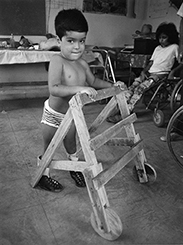 | |
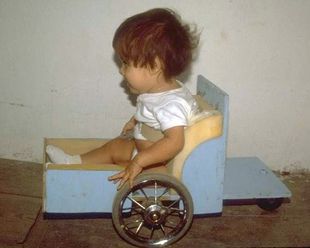 | |
| A child with spina bifida learns to walk with the help of a homemade walker. (PROJIMO) |
A one-year-old with spina bifida in a mini wheel-chair made by workers with disabilities. (PROJIMO) |



